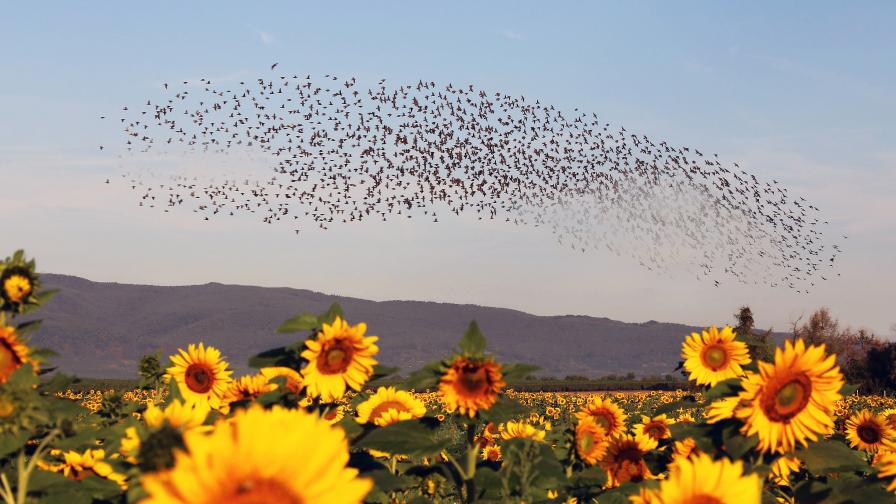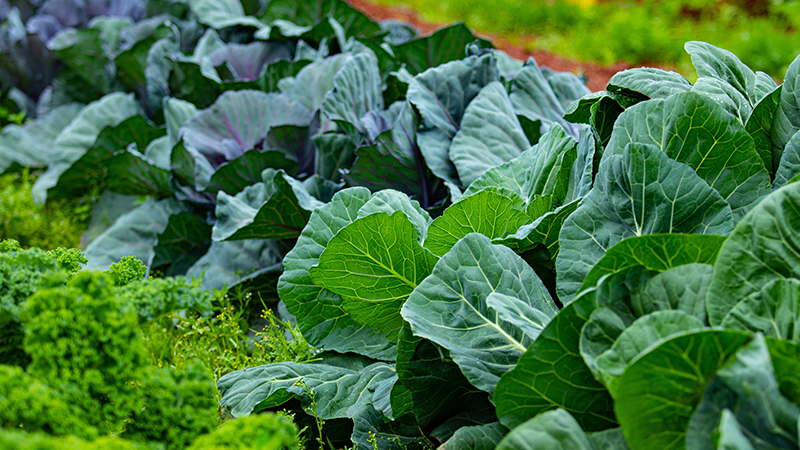Got Hungry Birds in Your Vineyard? Give Them a New Menu Item

A flock of starlings soar over a field of sunflowers.
Photo by U.J. Alexander, Adobe PhotoStock
Birds love grapes. Fortunately for vineyard managers, they reportedly love sunflower seeds even more. A trio of Iowa wine grape growers put that trait to test during the 2021 and 2022 growing seasons. Tired of losing fruit to pest birds, they conducted a study to measure the effectiveness of sunflowers as a companion planting in their vineyards. The two-pronged goal: minimize bird damage and determine labor feasibility while forsaking netting, which can be expensive and labor intensive
Coordinated by Kristy Walker of Walker Homestead Farm and Winery in Iowa City, the project — funded by the Sustainable Agriculture Research and Education (SARE) program — included John Barber of Ottawa Vineyards in Polk County and Chris Larson of Compass Hill Vineyard in Winterset. Specific to the SARE grant, the three farms combined included 4.5 acres of vineyards and 1.5 acres of sunflower.
“The important part for us using the sunflowers is not for the beautiful flowers but for the seeds to attract the birds,” Walker says. “They’re attracted to the protein — hopefully more than our grapes.”
Planting Plan
The growers began by applying Roundup 14 days prior to first tillage, which occurred just after the soils had warmed to 50° F. With a secondary goal of aesthetics in mind, seeds were divided evenly among four plantings once every two weeks, with the farthest patch being planted first.
‘Royal Hybrid’ seeds were planted 8 to 12 inches apart in rows spaced 18 to 36 inches apart. Depth was 1.5 inches. The high-yielding, early sunflower plants took 68 to 71 days to bloom and 100 to 110 days to seed.
Once the sunflowers appeared, the growers tilled or applied post-emergent Poast/Select to the grasses when they became 2 to 4 inches in height.
Ottawa Vineyards Experience
Working on two plots, Barber quickly discovered in 2021 that row cropping and its planting needs present a learning curve that may take one or two seasons to get comfortable with.
“Not being familiar with how the planters work, on the outside rows nothing came up on one side of the planter,” Barber says. “All the seed was going in the ground, but nothing materialized. Just the one side of the planter worked, and that was it. We were pretty discouraged about that.”
Then the weeds started coming up.
“I didn’t pull out the old clethodim to control those grasses like I should have,” Barber says. “But it didn’t matter because then the deer came, and they pretty much ate everything we had.”
Turkeys also appeared on the property for the first time, according to Barber. “This particular year we probably had 10 turkeys just hunting around there all the time,” he says. “I don’t think it had anything to do with this planting, but they were definitely there.”
Fortunately, Barber’s second (and larger) plot, despite being “extremely weedy” with foxtail, produced sunflowers, which the birds did enjoy, he says.
The 2022 planting started with a complete burn-off and then “perfect” tilling conditions, Barber says. The deer problem was also addressed upon erecting electric fencing. Unfortunately, Barber wound up with zero germination on both plots. Again, the lack of planting experience proved damning, he says.
In both seasons Barber wound up netting all of his grapes rather than half of them to prevent excess loss. With sunflowers to work with on the one plot in 2021, he experienced his best harvest ever at that site, a yield of 16.23 pounds per vine. In 2022, with no blooms to work with, the yield was substantially lower at 10.38 pounds per vine.
“A significant increase with the sunflowers (in 2021) — I don’t know if that was a fluke or what,” Barber concludes.
Compass Hill Experience
Like Barber, Larson learned the hard way that deer prefer sunflowers even more than birds. With 20,000 seeds planted in 2021, everything was “going great” the first few weeks. The sunflowers were hip high. After allowing the grasses to get too tall, Larson was then forced to spend a Sunday evening walking each row while hand spraying.
A few days later, he woke to find not a single leaf on any plant. Actually, a random plant here and there did eventually bloom, which made for a bittersweet meme. “If you’re looking to attract deer, this is a good way to do it,” Larson says. “Deer came in and ate every single growing point, and we were done for the season.”
Compass Hill adapted in 2022 by installing a 6-foot-high deer fence and cheap plastic deer netting outside the wires. Despite a cold, wet spring that delayed the final planting until June 4, the sunflowers thrived all summer. But they bloomed too late (Aug. 2) to gauge whether they helped the grapes. Worse yet, raccoons decimated Larson’s entire ‘Frontenac Blanc’ crop.
Thus, in 2021, with 100% netting, the ‘Frontenac Blanc’ was 7.39 pounds per vine compared to 0.77 pounds per vine in 2022. ‘Petite Pearl’ was 9.69 pounds per vine (all netted) in 2021 compared to 1.75 pounds per unnetted vine and 10.58 pounds per netted vine in 2022.
“Timing is critical,” Larson concludes. “You put yourself at risk if you’re going to try something like this. You’ve got to make sure you get it in when it’s supposed to be in. If it’s late, it’s just not going to work.”
Walker Homestead Experience
Whereas Barber and Larson had to fall back on netting to protect their grapes, Walker, in 2022, chose not to net her vines. She concludes that birds did prefer the sunflowers while ignoring her grapes.
“Visually we can see that we’re not getting a lot of (bird) pressure on our grapes,” she says. On top of that, the sunflowers attract ag tourism, which is a huge revenue stream, and attract pick-your-own customers, she notes.
In the end, for the companion planting of sunflowers to be successful, Walker advises:
- If there are preexisting issues with deer in the vineyard, growers must proactively protect the sunflower crop as well.
- Growers need the right tools to manage multiple plantings.
- Growers need to start with a clean field and then maintain weeds either chemically or by tilling or mowing the rows.










